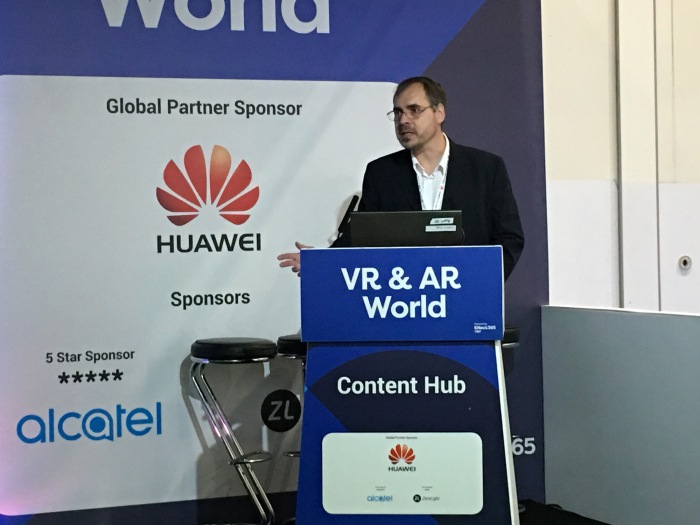We caught up with event supporters and speakers at this year’s event Diota, to find out how they’re providing software solutions centred around Augmented Reality, and to ask how they see Augmented and Virtual Reality technologies developing in the future.
Could you start by telling our readers about Diota Augmenting Industries and the services you provide?
Diota provides software solutions centered around Augmented Reality to enable large scale industrial players to link human and digital to increase their industrial performance. On the one hand, these solutions bring digital data in operational spaces to assist human operations; on the other hand they take data collected in the field to information systems to allow optimizing industrial processes. It creates a real synergy between digital data and human know-how, and this synergy generates performance both in the back office and in operational areas.
From which industries are you currently finding the highest demand for AR products and support?
Augmented reality is relevant in any industrial environment where operators have to carry out complex tasks, at any stage of the product life cycle. However, depending on the industry, augmented reality will be used differently. For example in the heavy industry, particularly aerospace, but also rail and shipbuilding, where operators need assistance to assemble unique products whose configuration varies, AR is for now mainly applied in manufacturing processes.
In the automotive industry, AR proves to be particularly relevant to help to design and configure cars, or else to produce and control prototypes. Another example can be taken in the chemical industry where AR considerably improves the understanding and mastering of complex phenomena or enhances training to risk prevention. We mainly work with these above mentioned industry sectors where not only demand is mature,
but also ROI has been verified.

What is it that makes Diota a leader in the AR field?
Our various collaborations with industrial partners have enabled us to observe that the demands and use cases of industrial companies could interbreed even if they had needs that were their own. We also found that key factors for them to move on to an operational phase with Augmented Reality were the flexibility the solution, and its capability to integrate their existing software and hardware environments, which is synonymous of ROI. So we took an early decision to develop a true generic software solution that would enable them to create with full autonomy Augmented Reality projects in direct connection with standard software solutions like PLM they already use for their 3D models and instruction sheets. Based on breakthrough technological assets, among which a marker less, robust and accurate tracking technology exclusive to us, we have created a multi-use, multi-support and plug-and-play software solution.
In a few clicks, an AR project can be created directly in the PLM and exported via our plugin DiotaConnect. This project can then be immediately played in our software platform DiotaPlayer. Moreover, the same project can be used in the operational space through various devices (tablets, sunglasses, projective systems). Finally, during its use, the user can write comments, take pictures, carry out quality controls the statuses of which are automatically recorded…All the data collected can be transferred directly to the back office, via a pdf reporting or, for some data, a synchronous connection to the information system.
Thanks to this comprehensive offer, and our partnerships with major integrators, our clients are now deploying AR across workstations and industrial sites, with great easiness as no expertise in AR is needed, neither in the back office nor in the operational space. We are no longer talking about proof of concepts in AR, but well about deployments at broad industrial scale, which contributes to a certain leadership of Diota in the field of industrial Augmented Reality.
What are the biggest challenges you face working in the AR space?
One of the biggest challenges is likely to make AR acceptable by operators, who are the  main users in the end. We must not forget that not only these new tools involve a change in their habits and work methods, but also that technology has often been opposed to human, and may be received with some reluctance. We do believe that digital technologies, as we see and provide them, are on the contrary to the service of human know-how which is irreplaceable. We now have to step up our education efforts as well as supporting change in collaboration with our industrial partners for this message to be the most audible possible.
main users in the end. We must not forget that not only these new tools involve a change in their habits and work methods, but also that technology has often been opposed to human, and may be received with some reluctance. We do believe that digital technologies, as we see and provide them, are on the contrary to the service of human know-how which is irreplaceable. We now have to step up our education efforts as well as supporting change in collaboration with our industrial partners for this message to be the most audible possible.
Do you feel that VR technology has a future outside of entertainment? For example, could you see any potential for VR to be used to help improve processes and service offerings in B2B industries?
Definitely, VR has potential outside of entertainment, especially but not only for education and training, for industry, the medical field… In this respect we see a true convergence of VR and AR.
Do you have any plans to work with VR technology?
It makes no doubt to us that AR reaches its full potential when it is in synergy with other technologies, especially with VR. So, quite naturally we are working closely with providers of VR solutions to new offers. We will have the opportunity to give a preview of joint solutions at our event “Augmenting Industries Day” by Diota on December 02.
What are you looking forward to the most about this year’s VR & AR World event?
VR and AR are among the technologies that have the wind in their sails. It is of course good for us (laughs), but a drawback can be that this craze, fed by example with games that buzz like Pokemon go, hides aspects a little more down to earth, less sexy but especially important in this period of time where the industry of the future, the digital factory…are not just hot topics but critical issues that shape our future, the way we work as well as the way we live… We count on the VR & AR World event to highlight these aspects and bring together all the best expertise and insights.
You can find out more about Diota, including where you can find them at VR & AR World here.

 “Broadcasters are starting to understand VR pretty well, but are still looking to start-ups and VR industry to build the features”, Andre Lorenceau Founder and CEO at LiveLike VR told a packed room at VR & AR World in London today. “They would rather let us pioneer this sort of this stuff and then license it from us.”
“Broadcasters are starting to understand VR pretty well, but are still looking to start-ups and VR industry to build the features”, Andre Lorenceau Founder and CEO at LiveLike VR told a packed room at VR & AR World in London today. “They would rather let us pioneer this sort of this stuff and then license it from us.”
 of video VR is an excellent concept, but not all of it works. You have to remember that it is not an extension of traditional TV and broadcast,” he warned. “We have to throw away 100 years of technique. VR is totally different.”
of video VR is an excellent concept, but not all of it works. You have to remember that it is not an extension of traditional TV and broadcast,” he warned. “We have to throw away 100 years of technique. VR is totally different.”
 Huawei chief architect of future networks Richard Li: “I saw some data from a survey on this topic before I came here. Of the 650 respondents, 78% people say gaming is number one [revenue source]. The principle driver is the number of VR gaming releases at the end of this year and we are yet to have Black Friday sales. 40% think TV is the next most powerful driver, but is being slowed by network issues. I believe we should also be looking at things like real estate and other major retail areas that can be done remotely. We should also look at education, which is a big market, as is medical.”
Huawei chief architect of future networks Richard Li: “I saw some data from a survey on this topic before I came here. Of the 650 respondents, 78% people say gaming is number one [revenue source]. The principle driver is the number of VR gaming releases at the end of this year and we are yet to have Black Friday sales. 40% think TV is the next most powerful driver, but is being slowed by network issues. I believe we should also be looking at things like real estate and other major retail areas that can be done remotely. We should also look at education, which is a big market, as is medical.” Daniel Doornink, founder & CEO VRBase: “Good content is going to be a big money maker, especially in gaming. But to get there you need a hit, but there hasn’t been one yet. If you want to make money in VR gaming, you need to check out all the learnings available now to try to get that hit. Robot Recall could become a big hit. You need to know what is good, what works and how to utilise this.”
Daniel Doornink, founder & CEO VRBase: “Good content is going to be a big money maker, especially in gaming. But to get there you need a hit, but there hasn’t been one yet. If you want to make money in VR gaming, you need to check out all the learnings available now to try to get that hit. Robot Recall could become a big hit. You need to know what is good, what works and how to utilise this.” Richard Vincent, partner at Fundamental VR: “think about things that VR actually makes better. It could be in HR, training or simulation, for video presence. For business. I brie ve this is the next platform, just look at how mobile accelerated. Now is the time to hone in on, what competency do you need. Now is the time to acquire that knowledge.”
Richard Vincent, partner at Fundamental VR: “think about things that VR actually makes better. It could be in HR, training or simulation, for video presence. For business. I brie ve this is the next platform, just look at how mobile accelerated. Now is the time to hone in on, what competency do you need. Now is the time to acquire that knowledge.” Randolph Nikutta, leader interactive high-end media, Telekom Innovation Laboratories at Deutsche Telekom: “If you look at it from the consumer view. How speedy will the transition be between big screens and these screens. I doubt this will happen in the next three to four years. It is about fighting for consumer time. This is where the industry is still in a trial phase. and that’s where they have to spend money and time.“
Randolph Nikutta, leader interactive high-end media, Telekom Innovation Laboratories at Deutsche Telekom: “If you look at it from the consumer view. How speedy will the transition be between big screens and these screens. I doubt this will happen in the next three to four years. It is about fighting for consumer time. This is where the industry is still in a trial phase. and that’s where they have to spend money and time.“ Mathieu Ducrot, head of apps anticipation & connected ecosystems at Orange: “We have begun building some premium experiences in content. We believe that if you want want day to have the right monetise you need to build a market now, with proper hardware and content to embed the experience in market.”
Mathieu Ducrot, head of apps anticipation & connected ecosystems at Orange: “We have begun building some premium experiences in content. We believe that if you want want day to have the right monetise you need to build a market now, with proper hardware and content to embed the experience in market.” David Edge, associate & visualisation leader at Arup: “We need to understand the holistic total picture for constructive dialogue of VR. It really changes the way we work. It means we can change and possibly descale rational work streams, from contrition, planning, marketing and more. It allows for a better level of understanding by letting you see from every angle.”
David Edge, associate & visualisation leader at Arup: “We need to understand the holistic total picture for constructive dialogue of VR. It really changes the way we work. It means we can change and possibly descale rational work streams, from contrition, planning, marketing and more. It allows for a better level of understanding by letting you see from every angle.”
 He explained that standard definition (SD) VR needs a bit rate of 100 Mbps.
He explained that standard definition (SD) VR needs a bit rate of 100 Mbps. In a talk where he tried to avoid numbers, Ovum Principal Analyst Paul Jackson described how Ovum sees the VR/AR market shaping up over the next four years.
In a talk where he tried to avoid numbers, Ovum Principal Analyst Paul Jackson described how Ovum sees the VR/AR market shaping up over the next four years. And then there’s Magic Leap (pictured left), he said. The Minority Report-style AR company has gathered USD$1.4 billion in investment, but a “product is still rumoured to be 18 months out”.
And then there’s Magic Leap (pictured left), he said. The Minority Report-style AR company has gathered USD$1.4 billion in investment, but a “product is still rumoured to be 18 months out”.
 main users in the end. We must not forget that not only these new tools involve a change in their habits and work methods, but also that technology has often been opposed to human, and may be received with some reluctance. We do believe that digital technologies, as we see and provide them, are on the contrary to the service of human know-how which is irreplaceable. We now have to step up our education efforts as well as supporting change in collaboration with our industrial partners for this message to be the most audible possible.
main users in the end. We must not forget that not only these new tools involve a change in their habits and work methods, but also that technology has often been opposed to human, and may be received with some reluctance. We do believe that digital technologies, as we see and provide them, are on the contrary to the service of human know-how which is irreplaceable. We now have to step up our education efforts as well as supporting change in collaboration with our industrial partners for this message to be the most audible possible.
